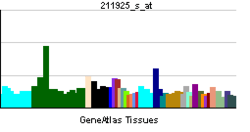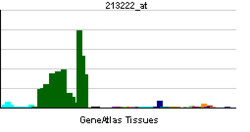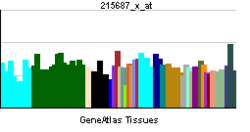PLCB1
1-Phosphatidylinositol-4,5-bisphosphate phosphodiesterase beta-1 is an enzyme that in humans is encoded by the PLCB1 gene.[1][2][3]
Function
The protein encoded by this gene catalyzes the formation of inositol 1,4,5-trisphosphate and diacylglycerol from phosphatidylinositol 4,5-bisphosphate. This reaction uses calcium as a cofactor and plays an important role in the intracellular transduction of many extracellular signals. This gene is activated by two G-protein alpha subunits, alpha-q and alpha-11. Two transcript variants encoding different isoforms have been found for this gene.[3]
Interactions
PLCB1 has been shown to interact with TRPM7.[4]
Pathology
Homozygous PLCB1 deletion is associated with malignant migrating partial seizures in infancy.[5]
References
- ↑ Peruzzi D, Calabrese G, Faenza I, Manzoli L, Matteucci A, Gianfrancesco F et al. (Jun 2000). "Identification and chromosomal localisation by fluorescence in situ hybridisation of human gene of phosphoinositide-specific phospholipase C beta(1)". Biochim. Biophys. Acta 1484 (2-3): 175–82. doi:10.1016/s1388-1981(00)00012-3. PMID 10760467.
- ↑ Caricasole A, Sala C, Roncarati R, Formenti E, Terstappen GC (Jan 2001). "Cloning and characterization of the human phosphoinositide-specific phospholipase C-beta 1 (PLC beta 1)". Biochim. Biophys. Acta 1517 (1): 63–72. doi:10.1016/S0167-4781(00)00260-8. PMID 11118617. Check date values in:
|year= / |date= mismatch(help) - ↑ 3.0 3.1 "Entrez Gene: PLCB1 phospholipase C, beta 1 (phosphoinositide-specific)".
- ↑ Runnels LW, Yue L, Clapham DE (May 2002). "The TRPM7 channel is inactivated by PIP(2) hydrolysis". Nat. Cell Biol. 4 (5): 329–36. doi:10.1038/ncb781. PMID 11941371.
- ↑ Poduri A, Chopra SS, Neilan EG, Elhosary PC, Kurian MA, Meyer E et al. (2012). "Homozygous PLCB1 deletion associated with malignant migrating partial seizures in infancy". Epilepsia 53 (8): e146–50. doi:10.1111/j.1528-1167.2012.03538.x. PMC 3851296. PMID 22690784.
Further reading
- Nakajima D, Okazaki N, Yamakawa H, Kikuno R, Ohara O, Nagase T (2002). "Construction of expression-ready cDNA clones for KIAA genes: manual curation of 330 KIAA cDNA clones". DNA Res. 9 (3): 99–106. doi:10.1093/dnares/9.3.99. PMID 12168954.
- Martelli AM, Fiume R, Faenza I, Tabellini G, Evangelista C, Bortul R et al. (2005). "Nuclear phosphoinositide specific phospholipase C (PI-PLC)-beta 1: a central intermediary in nuclear lipid-dependent signal transduction". Histol. Histopathol. 20 (4): 1251–60. PMID 16136505.
- Cocco L, Follo MY, Faenza I, Bavelloni A, Billi AM, Martelli AM et al. (2007). "Nuclear inositide signaling: an appraisal of phospholipase C beta 1 behavior in myelodysplastic and leukemia cells". Adv. Enzyme Regul. 47: 2–9. doi:10.1016/j.advenzreg.2006.12.003. PMID 17335878.
- Cefai D, Debre P, Kaczorek M, Idziorek T, Autran B, Bismuth G (1990). "Human immunodeficiency virus-1 glycoproteins gp120 and gp160 specifically inhibit the CD3/T cell-antigen receptor phosphoinositide transduction pathway". J. Clin. Invest. 86 (6): 2117–24. doi:10.1172/JCI114950. PMC 329852. PMID 1979339.
- Zauli G, Previati M, Caramelli E, Bassini A, Falcieri E, Gibellini D et al. (1995). "Exogenous human immunodeficiency virus type-1 Tat protein selectively stimulates a phosphatidylinositol-specific phospholipase C nuclear pathway in the Jurkat T cell line". Eur. J. Immunol. 25 (9): 2695–700. doi:10.1002/eji.1830250944. PMID 7589147.
- Hwang SC, Park KH, Ha MJ, Noh IS, Park TB, Lee YH (1996). "Distribution of phospholipase C isozymes in normal human lung tissue and their immunohistochemical localization". J. Korean Med. Sci. 11 (4): 305–13. doi:10.3346/jkms.1996.11.4.305. PMC 3054083. PMID 8878798.
- Chen P, Mayne M, Power C, Nath A (1997). "The Tat protein of HIV-1 induces tumor necrosis factor-alpha production. Implications for HIV-1-associated neurological diseases". J. Biol. Chem. 272 (36): 22385–8. doi:10.1074/jbc.272.36.22385. PMID 9278385.
- Nagase T, Ishikawa K, Miyajima N, Tanaka A, Kotani H, Nomura N et al. (1998). "Prediction of the coding sequences of unidentified human genes. IX. The complete sequences of 100 new cDNA clones from brain which can code for large proteins in vitro". DNA Res. 5 (1): 31–9. doi:10.1093/dnares/5.1.31. PMID 9628581.
- Snow BE, Hall RA, Krumins AM, Brothers GM, Bouchard D, Brothers CA et al. (1998). "GTPase activating specificity of RGS12 and binding specificity of an alternatively spliced PDZ (PSD-95/Dlg/ZO-1) domain". J. Biol. Chem. 273 (28): 17749–55. doi:10.1074/jbc.273.28.17749. PMID 9651375.
- Mayne M, Bratanich AC, Chen P, Rana F, Nath A, Power C (1998). "HIV-1 tat molecular diversity and induction of TNF-alpha: implications for HIV-induced neurological disease". Neuroimmunomodulation 5 (3-4): 184–92. doi:10.1159/000026336. PMID 9730685.
- Haughey NJ, Holden CP, Nath A, Geiger JD (1999). "Involvement of inositol 1,4,5-trisphosphate-regulated stores of intracellular calcium in calcium dysregulation and neuron cell death caused by HIV-1 protein tat". J. Neurochem. 73 (4): 1363–74. doi:10.1046/j.1471-4159.1999.0731363.x. PMID 10501179.
- Mayne M, Holden CP, Nath A, Geiger JD (2000). "Release of calcium from inositol 1,4,5-trisphosphate receptor-regulated stores by HIV-1 Tat regulates TNF-alpha production in human macrophages". J. Immunol. 164 (12): 6538–42. doi:10.4049/jimmunol.164.12.6538. PMID 10843712.
- Tang Y, Tang J, Chen Z, Trost C, Flockerzi V, Li M et al. (2000). "Association of mammalian trp4 and phospholipase C isozymes with a PDZ domain-containing protein, NHERF". J. Biol. Chem. 275 (48): 37559–64. doi:10.1074/jbc.M006635200. PMID 10980202.
- Dowal L, Elliott J, Popov S, Wilkie TM, Scarlata S (2001). "Determination of the contact energies between a regulator of G protein signaling and G protein subunits and phospholipase C beta 1". Biochemistry 40 (2): 414–21. doi:10.1021/bi001923. PMID 11148035.
- Xu A, Wang Y, Xu LY, Gilmour RS (2001). "Protein kinase C alpha -mediated negative feedback regulation is responsible for the termination of insulin-like growth factor I-induced activation of nuclear phospholipase C beta1 in Swiss 3T3 cells". J. Biol. Chem. 276 (18): 14980–6. doi:10.1074/jbc.M009144200. PMID 11278470.
- Xu A, Suh PG, Marmy-Conus N, Pearson RB, Seok OY, Cocco L et al. (2001). "Phosphorylation of nuclear phospholipase C beta1 by extracellular signal-regulated kinase mediates the mitogenic action of insulin-like growth factor I". Mol. Cell. Biol. 21 (9): 2981–90. doi:10.1128/MCB.21.9.2981-2990.2001. PMC 86927. PMID 11287604.
- Vitale M, Matteucci A, Manzoli L, Rodella L, Mariani AR, Zauli G et al. (2001). "Interleukin 2 activates nuclear phospholipase Cbeta by mitogen-activated protein kinase-dependent phosphorylation in human natural killer cells". FASEB J. 15 (10): 1789–91. doi:10.1096/fj.01-0008fje. PMID 11481231.
- Singer AU, Waldo GL, Harden TK, Sondek J (2002). "A unique fold of phospholipase C-beta mediates dimerization and interaction with G alpha q". Nat. Struct. Biol. 9 (1): 32–6. doi:10.1038/nsb731. PMID 11753430.


